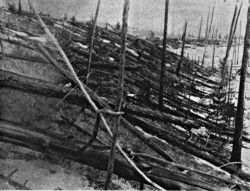Welcome to DU!
The truly grassroots left-of-center political community where regular people, not algorithms, drive the discussions and set the standards.
Join the community:
Create a free account
Support DU (and get rid of ads!):
Become a Star Member
Latest Breaking News
General Discussion
The DU Lounge
All Forums
Issue Forums
Culture Forums
Alliance Forums
Region Forums
Support Forums
Help & Search
General Discussion
Related: Editorials & Other Articles, Issue Forums, Alliance Forums, Region ForumsIf you think this meteor was powerful, you need to know about Tunguska in Siberia in 1908

At 7:17 am on June 30, 1908 an explosion was heard and felt that has become referred to as the Tunguska event. The only true way to understand the magnitude of this event is by comparing observations made at different distances. Seismic vibrations were recorded by sensitive instruments as much as 1000 km away. At 500 km, observers reported “deafening bangs” and a fiery cloud on the horizon.
About 170 km from the explosion, the object was seen in the cloudless, daytime sky as a brilliant, sun-like fireball and thunderous, deafening noises were heard. At a distance of about around 60 km, people were thrown to the ground or even knocked unconscious. Windows were broken and pottery was knocked off shelves. The closest observers were some reindeer herders asleep in their tents in several camps about 30 km from the site. Some were blown into the air and knocked unconscious. One man was blown into a tree and later died. “Everything around was shrouded in smoke and fog from the burning fallen trees.”
The Tunguska event may have exploded above the surface of the Earth, but it exploded with the force of 15 megatons of TNT. The blast knocked over 80 million trees over an area of 2,150 square km. The event would have measured a 5.0 on the Richter scale if it had been in use at the time.
Some scientist think that a 1m portion of the asteroid from the Tunguska event may have impacted the Earth and formed Lake Cheko. Silt depth indicates that the lake is only 100 years old and acoustic-echo soundings revealed a conical shape for the lake bed, which is consistent with an impact crater. Also, magnetic readings indicate a possible meter-sized chunk of rock below the lake’s deepest point, which may be a fragment of the colliding body. Finally, the lake’s long axis points to the hypocenter of the Tunguska event, which is about 7 km away.
There have been many theories given for the explosion and damage done during the Tunguska event. An asteroid is the most plausible. This evidence includes fragments of high-nickel magnetic spheres around the site. Very little is really known about the event because of the remoteness of the impact and the secretive nature of the area’s government. Compounding these problems is the fact that no one explored the area for nearly 30 years after the event took place.
http://www.universetoday.com/37487/tunguska-event/
And what really happened is still be ing argued about.
InfoView thread info, including edit history
TrashPut this thread in your Trash Can (My DU » Trash Can)
BookmarkAdd this thread to your Bookmarks (My DU » Bookmarks)
2 replies, 1145 views
ShareGet links to this post and/or share on social media
AlertAlert this post for a rule violation
PowersThere are no powers you can use on this post
EditCannot edit other people's posts
ReplyReply to this post
EditCannot edit other people's posts
Rec (3)
ReplyReply to this post
2 replies
 = new reply since forum marked as read
Highlight:
NoneDon't highlight anything
5 newestHighlight 5 most recent replies
= new reply since forum marked as read
Highlight:
NoneDon't highlight anything
5 newestHighlight 5 most recent replies
If you think this meteor was powerful, you need to know about Tunguska in Siberia in 1908 (Original Post)
Are_grits_groceries
Feb 2013
OP
longship
(40,416 posts)1. "You have been a participant in the biggest interdimensional cross-rip since the Tunguska blast...
...of 1909."
Well, Ackroyd got the year wrong.
Puzzledtraveller
(5,937 posts)2. Been a Tunguska enthusiast since I first read about it